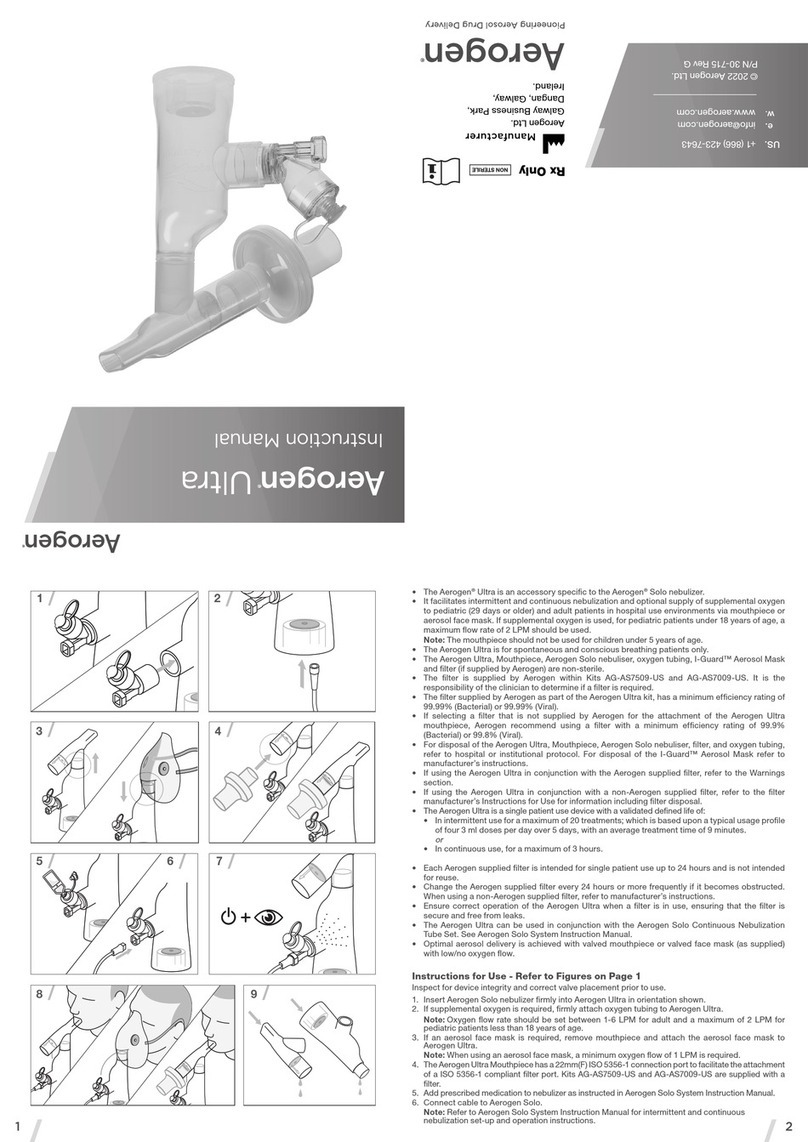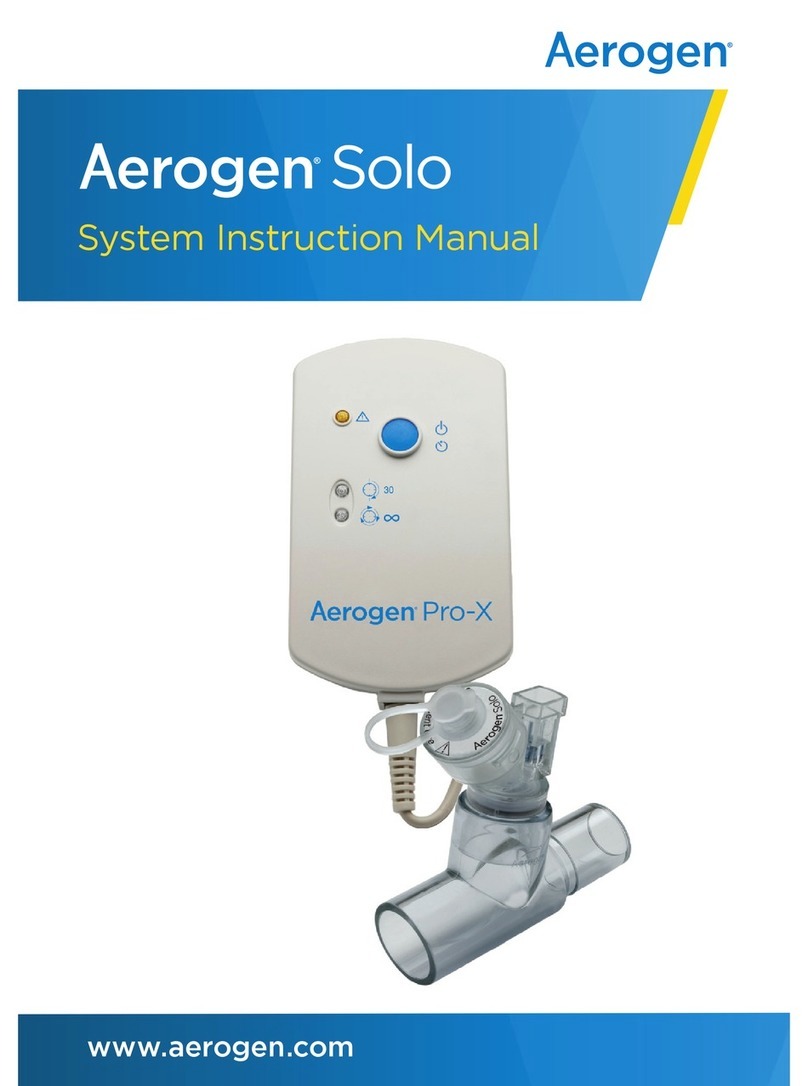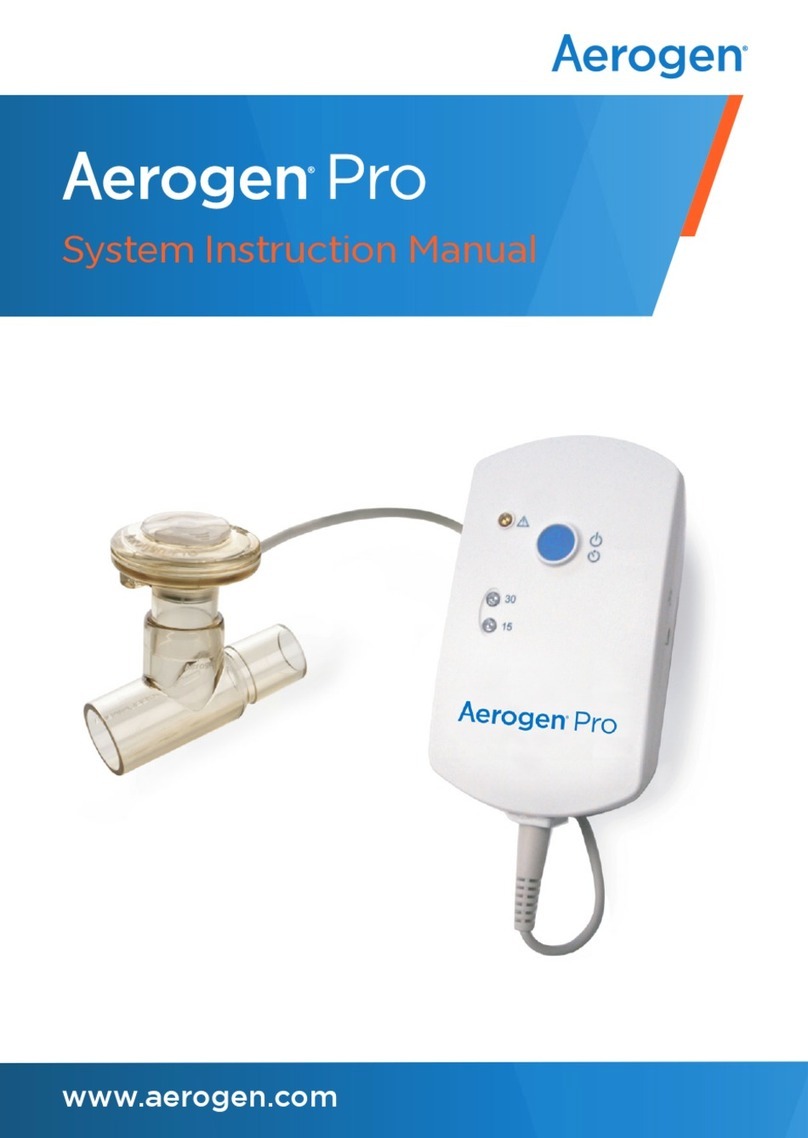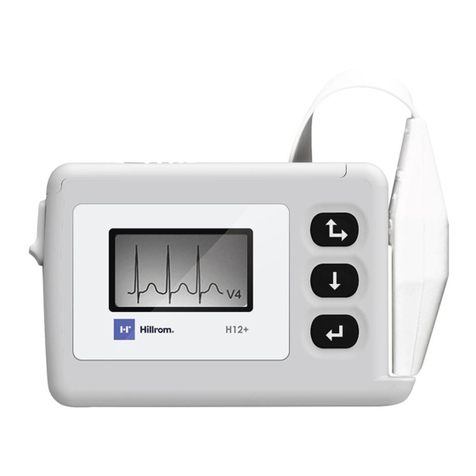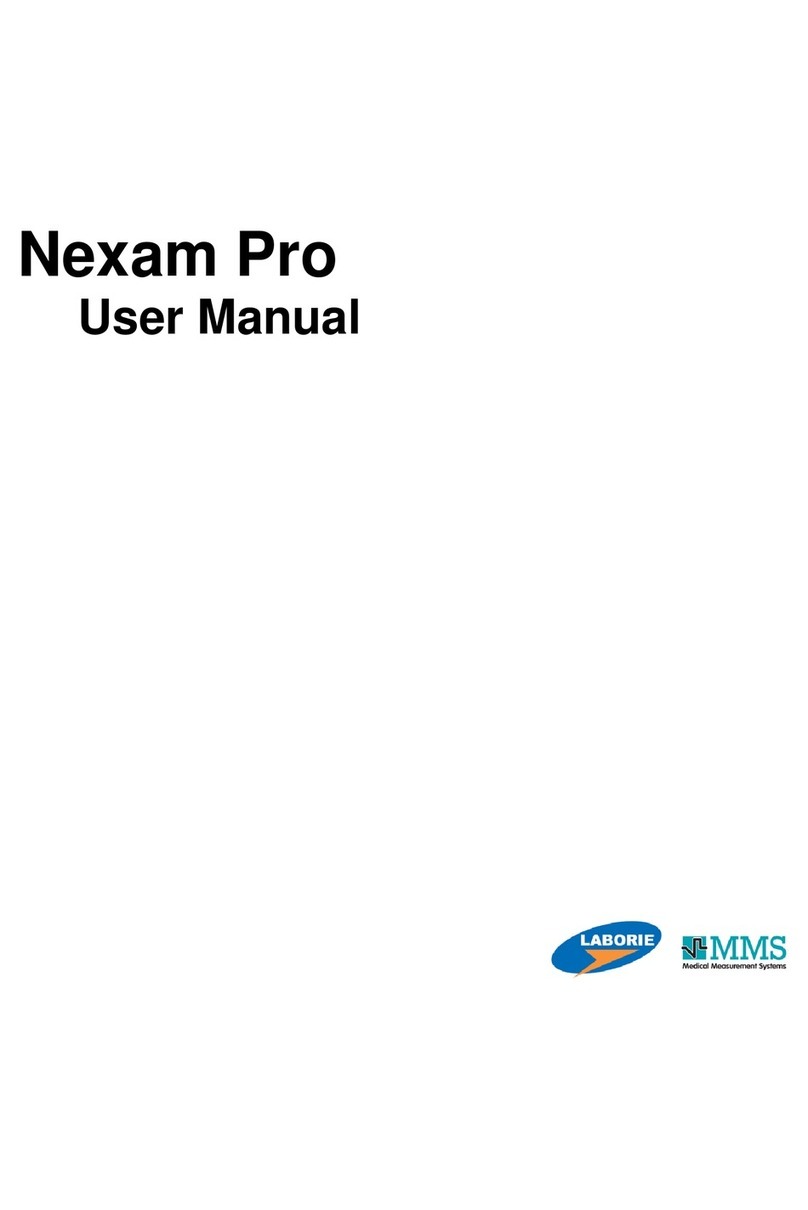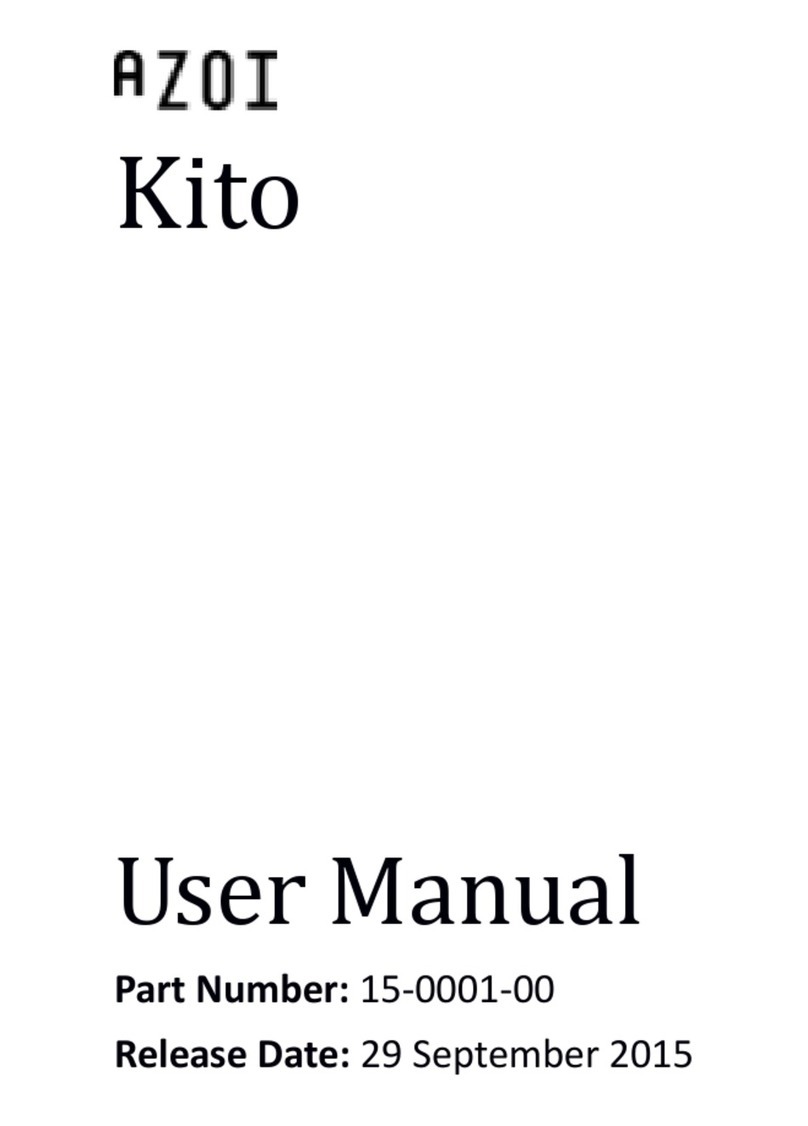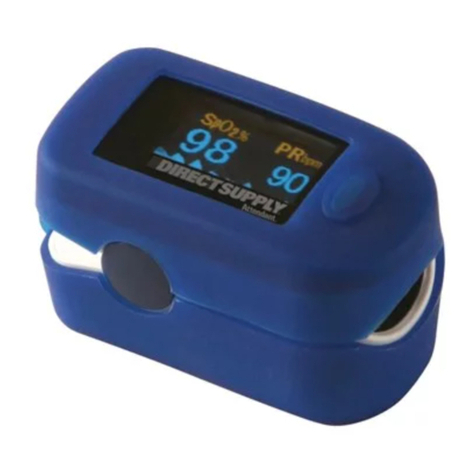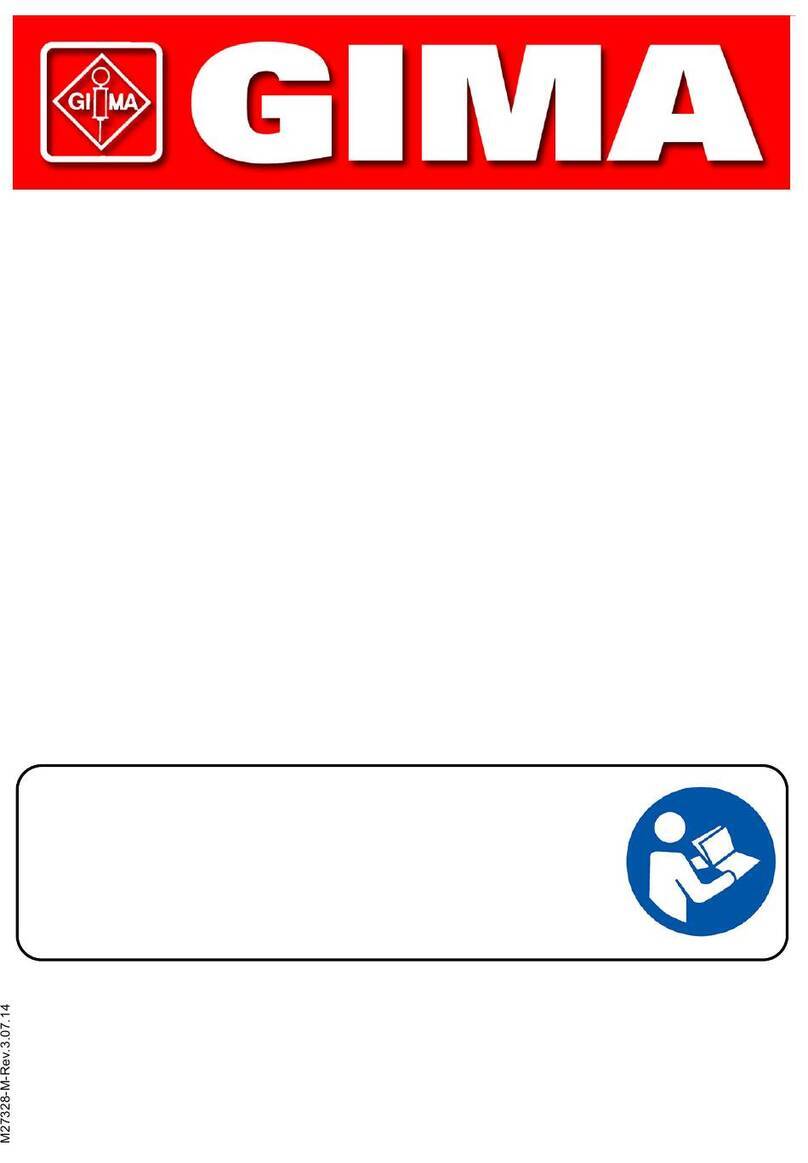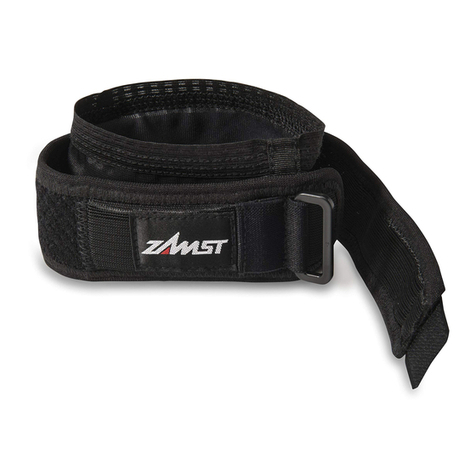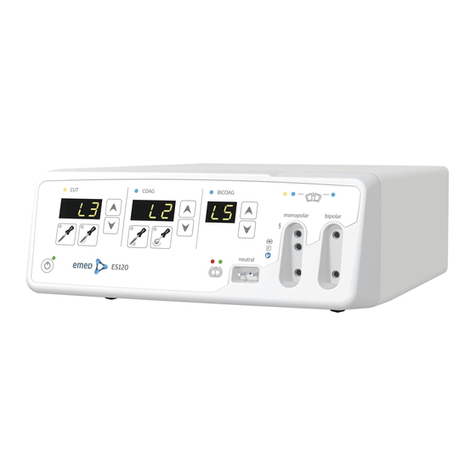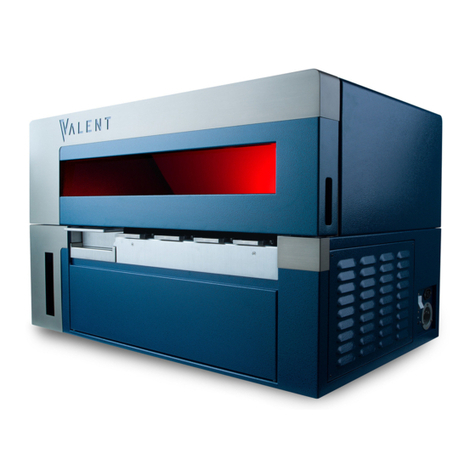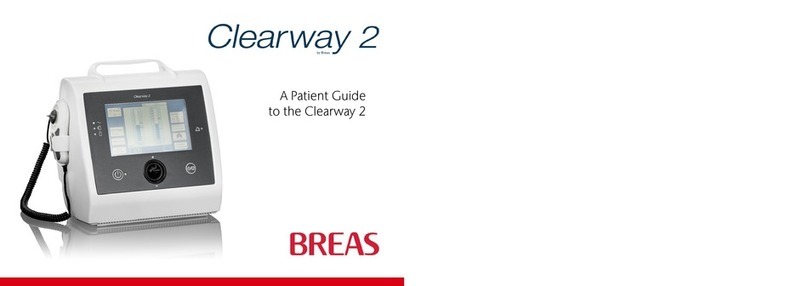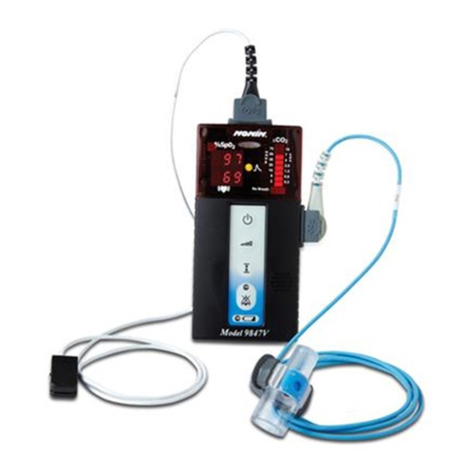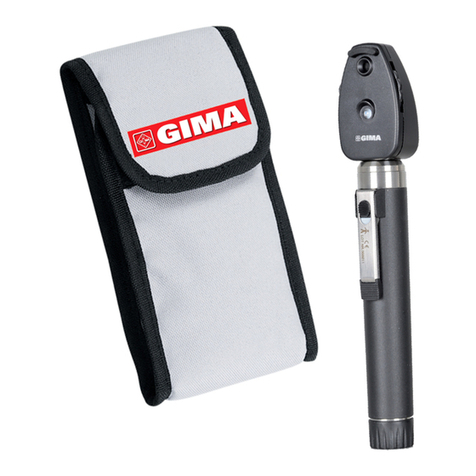Aerogen Aerogen USB Controller User manual

Hospital Use page 1
Home Use page 38
for use with Aerogen® Solo
and Aerogen®Pro
System Instruction Manual
www.aerogen.com


Aerogen®USB Controller System Instruction Manual
1
Aerogen®USB Controller
System Instruction Manual
for use with Aerogen®Solo
and Aerogen®Pro
HOSPITAL USE

Aerogen®
2
Contents
Introduction 3
Indications for Use 3
Set Up 6
System Warnings 9
Controls & Indicators 13
Accessories 14
Functional Test 23
Aerogen Solo Aerosol Flow Rate Calculation 24
Cleaning of the Aerogen USB Controller System 25
Troubleshooting 30
Warranty 31
Life Of Products 31
Specifications 32
Aerogen Solo Performance 33
Aerogen Pro Performance 35
Power 36
Symbols Glossary 37
Appendix 1: EMC Tables 64

Aerogen®USB Controller System Instruction Manual
3
Introduction
The Aerogen®USB Controller System is:
•A portable medical device that is intended to aerosolize physician-
prescribed medications for inhalation.
•The Aerogen®USB Controller should only be operated from mains
using the Aerogen USB Controller AC/DC Adapter.
•An alternative to the existing Aerogen®Pro and Aerogen®Pro-X
Controllers.
Indications for Use
The Aerogen®USB Controller System includes the Aerogen®Pro and
Aerogen®Solo Nebulizers, which are intended to aerosolize physician-
prescribed medications for inhalation to patients on and off ventilation or
other positive pressure breathing assistance in the hospital environment,
and on vent only in the homecare environment.
The Aerogen®Pro Nebulizer is intended for multiple patient use in
hospital environment and single patient use in home environment.
Aerogen®Solo Nebulizer is for single patient use. Both nebulizers are for
pediatric (29 days or older) and adult patients.

Aerogen®
4
The Aerogen USB Controller can be used with Aerogen nebulizers as
follows:
Table 1. Intended Use Summary
Intended Use Summary Aerogen Solo
Nebulizer
Aerogen Pro
Nebulizer
Hospital - Ventilated patients
Hospital -Spontaneously Breathing Patients
30 Minute Mode Operation
6 Hour Mode Operation

Aerogen®USB Controller System Instruction Manual
5
Aerogen USB Controller System
Figure 1. Aerogen USB Controller System (Items Provided)
1. Aerogen USB Controller (Multiple patient use)
2. Aerogen Solo Nebulizer (Single patient use)
Aerogen Pro Nebulizer (Multiple patient use)
3. Aerogen Solo T-Piece & Silicone Plug (Single patient use)
Aerogen Pro T-Piece & Silicone Plug (Multiple patient use)
4. Cable Management Clips (Multiple patient use)
5. Aerogen USB Controller AC/DC Adapter (Multiple patient use)
Aerogen
Solo
Aerogen
Pro
12
3 4 5

Aerogen®
6
Set Up
Read and study all instructions before using the Aerogen USB Controller.
Perform a functional test of the Aerogen nebulizer prior to use as described
in the Functional Test section of this manual (see page 23).
Connect the Aerogen Solo or Aerogen
Pro nebulizer by firmly pushing into
the T-piece.
Connect the Aerogen USB Controller
to the nebulizer as shown.
Insert the nebulizer and the T-piece*
in the breathing circuit.
* Adult T-Piece shown here. For full
instruction on T-piece location see
page 14 (T-piece Accessories).
1
2
3

Aerogen®USB Controller System Instruction Manual
7
Alternative Set Up:
The Aerogen Solo can be placed on
the dry side of the humidifier.
Connect the Aerogen USB Controller
to the Aerogen USB Controller AC/DC
Adapter.
Open the plug on the nebulizer and
use a pre-filled ampoule or syringe
to add medication to the nebulizer.
Close the plug.
Note: To avoid damage to the
Aerogen Solo, do not use a syringe
with a needle.
4
5

Aerogen®
8
To operate in 30 Minute Mode press
the On/Off button once.
To operate in 6 Hour Mode press the
On/Off button from the off mode for
>3 seconds.
Note: Verify the correct mode of
operation is selected.
Verify that aerosol is visible.
Note: Clips are provided to assist with cable management.
30 Min.
6 Hr.
USB
Controller
On/Of f Timer
30 Min.
6 Hr.
USB
Controller
On/Of f Timer
1s > 3s
6
7

Aerogen®USB Controller System Instruction Manual
9
System Warnings
Read and study all instructions before using the Aerogen USB Controller
System.
Only trained persons should operate the Aerogen USB Controller System,
Aerogen Solo, Aerogen Pro and associated accessories.
If this product is being used to treat a life threatening condition, a backup
device is necessary.
During use observe for correct functioning of the nebulizer by regularly
verifying aerosol is visible and that no amber indicator lights are illuminated.
Do not use a filter or heat-moisture exchanger (HME) between the nebulizer
and patient airway.
Only use with HME devices whose manufacturer’s instructions allow use
with a nebulizer, and always follow the HME manufacturer’s instructions.
Ensure that the total combined volume of nebulizer, T-piece and HME is
suitable for the tidal volume being delivered and does not increase dead
space to the extent that it adversely impacts the ventilatory parameters of
the patient.
Always monitor the resistance to flow and excessive rain-out and change
the HME device as per manufacturer’s instructions.
The Aerogen nebulizers, T-pieces and accessories are not sterile.
The components and accessories of the Aerogen USB Controller System
are not made with natural rubber latex.
Only use physician-prescribed solutions that are approved for use with
a general purpose nebulizer. Consult drug manufacturer’s instructions
regarding suitability for nebulization.

10
Aerogen®
Only use the Aerogen nebulizer technology with components specified
in the instruction manuals. Use of the Aerogen nebulizer technology with
components other than those specified in the Instruction Manual may
result in increased emissions or decreased immunity of the nebulizer
system.
Do not place the Aerogen USB Controller in an incubator during use.
To avoid exhaled medication affecting the ventilator, follow ventilator
manufacturer’s recommendations for use of a bacterial filter in the
expiratory limb of a breathing circuit.
Do not use in the presence of flammable substances or flammable
anesthetic mixtures combined with air, oxygen or nitrous oxide.
To avoid the risk of fire do not use to aerosolize alcohol-based medications,
which can ignite in oxygen-enriched air under high pressure.
Do not modify this equipment without the authorization of the manufacturer.
Inspect all parts before use, and do not use if any parts are missing,
cracked or damaged. In case of missing parts, malfunction or damage,
contact your sales representative.
Do not immerse or autoclave the Aerogen USB Controller or Aerogen USB
Controller AC/DC Adapter.
Do not microwave any parts.
Do not use or store outside of specified environmental conditions.
Follow local laws and recycling plans regarding disposal or recycling of
components and packaging.
Do not use in the presence of devices generating high electromagnetic
fields such as magnetic resonance imaging (MRI) equipment.

Aerogen®USB Controller System Instruction Manual
11
Do not use the Aerogen USB Controller adjacent to or stacked with other
equipment. If adjacent or stacked use is necessary, the device should be
observed to verify normal operation in this configuration.
Portable and mobile radio frequency (“RF”) communication devices can
disrupt medical electrical equipment.
The Aerogen Solo is a single patient use device not to be used on more
than one patient to prevent cross infection.
Keep all cables tidy to avoid tripping or strangulation hazards.
Ensure that the Aerogen USB Controller cable is removed from the power
supply host using the grip feature provided.
Do not attempt to clean the device while in use.
Do not obstruct the removal of the Aerogen USB Controller AC/DC Adapter
from the mains.
Do not store the Aerogen USB Controller System in a location where it is
exposed to direct sunlight, extreme heat or cold, dust or moisture.
Do not operate the Aerogen USB Controller from USB ports on medical
equipment or non-medical equipment, the controller should only be
operated from the mains power supply.
Condensate can collect and occlude ventilator circuits. Always position
ventilator circuits so that fluid condensate drains away from the patient.
To avoid damage to the Aerogen Palladium vibrating mesh technology:
•Do not apply undue pressure to the domed aperture plate in the centre
of the nebulizer (Figure 2).
•Do not push out the Aerogen Vibronic®aerosol generator.
•Do not use a syringe with a needle to add medication.

12
Aerogen®
•Do not use abrasive or sharp tools to clean the nebulizer.
•Prior to use, autoclave the Aerogen Pro and accessories according to
specified directions and temperature given in the Cleaning, Disinfection
and Sterilization section of this Instruction Manual only. Any deviation
from directions given in this Instruction Manual may cause damage to
the nebulizer and render it inoperable.
Figure 2. Aerogen Palladium Vibrating Mesh Technology (Aerogen Vibronic®)
Use of the Aerogen Solo and T-piece during the administration of volatile
anesthetics may result in adverse effects on the constituent plastics. Do
not use with volatile anesthetics unless known to be compatible. Aerogen
have determined that, using anesthetic ventilators, the following volatile
anesthetic agents are compatible under the stated conditions below:
Anaesthetic Agent Proprietary Name
Maximum
Percentage of
Anaesthetic
Maximum Duration
of Exposure
Isoflurane FORANE®3.5 % 12 hours
Sevoflurane SEVOFLURANE®8 % 12 hours
Desflurane SUPRANE®10 % 12 hours

Aerogen®USB Controller System Instruction Manual
13
Controls & Indicators
Figure 3. Aerogen USB Controller Controls & Indicators
Table 2. Aerogen USB Controller Controls & Indicators
Control / Indicator Function
30 Min. Indicator
• Green = 30 Minute nebulization cycle on.
• Amber = Nebulizer disconnect.
• Aerogen USB Controller automatically powers
off after 30 minutes have elapsed.
6 Hr. Indicator
• Green = 6 hour nebulization cycle on.
• Amber = Nebulizer disconnect
• Aerogen USB Controller automatically powers
off after 6 hours have elapsed.
Error Indicator
• 30 Minute and 6 Hour Indicators flash amber
alternatively twice = Internal error condition.
Aerogen USB Controller automatically powers
off.
On/Off Power Button
• To operate in 30 Minute Mode press the On/Off
button once.
• To operate in 6 Hour Mode press and hold the
On/Off button for greater than 3 seconds.
• Pressing during nebulization turns off power to
the nebulizer.
30 Min.
6 Hr.
USB
Controller
On/Off Timer
30 Minute Mode Indicator light
6 Hour Mode Indicator light
On/Off Control

14
Aerogen®
Accessories
T-Pieces - Connection To A Breathing Circuit
Adult & Pediatric Circuit
For adult and pediatric patients, connect
the nebulizer with T-piece into the
inspiratory limb of the breathing circuit
before the patient Y.
Alternative Pediatric Circuit
Connect the nebulizer to 10mm pediatric
breathing circuits with the 15mm pediatric
T-piece and the pediatric adapters. This
can be positioned approximately 30 cm
(12 in.) back from the patient Y.
Dry Side of the Humidifier
The Aerogen Solo can be placed on
the dry side of the humidifier as shown.
The Aerogen Solo can be used with a
nasal interface in this configuration. The
Aerogen Pro is not recommended for
use on the dry side of the humidifier.

Aerogen®USB Controller System Instruction Manual
15
Between the Wye and Endotracheal Tube
The Aerogen Solo can be placed between
the wye and endotracheal tube as shown.
The Aerogen Solo can be used with a Heat
and Moisture Exchange Device (HME)
which may contain a filter.
Between the HME and Endotracheal Tube
Only a HME approved for use with
a nebulizer should be used in this
configuration (as shown). Follow the HME
manufacturer instructions regarding use
with a nebulizer. Ensure the combination
of nebulizer, T-piece and HME volumes
is suitable for the tidal volume being
delivered. See Table 5 for T-piece volumes.
Note: Always perform a leak test of the breathing circuit after inserting or
removing the nebulizer.
Follow ventilator manufacturer instructions for performing a leak test.
For additional T-piece Adapters visit www.aerogen.com for full
parts list.

16
Aerogen®
Connection To A Face Mask - Mouthpiece
Face Mask
Mask kits, which include a vented elbow
and mask elbow, are available separately
(visit www.aerogen.com for full parts list).
Note: When using a mask, connect the
vented elbow, mask elbow and mask to
the nebulizer by firmly pushing the parts
together.
Rotate the vented elbow to suit the position
of the patient.
Mouthpiece
When using a standard ISO 22 mm
mouthpiece, connect the nebulizer to the
T-piece as shown, and connect the T-piece
to the mouthpiece by pushing the parts
firmly together.
Note: To ensure correct nebulization,
maintain the nebulizer in a vertical
orientation.
Use With A Nasal Interface
The Aerogen Solo can be used on/off ventilator with a nasal interface
when configured with a humidifier.

Aerogen®USB Controller System Instruction Manual
17
Oxygen Tubing
Face Mask
Aerogen Solo
Mouthpiece
Aerogen Ultra
Aerogen®Ultra
The Aerogen Ultra is an accessory specific to the Aerogen®Solo Nebulizer.
It facilitates intermittent and continuous nebulization and optional supply
of supplemental oxygen to pediatric (29 days or older) and adult patients
in hospital use environments via a mouthpiece or aerosol face mask. If
supplemental oxygen is used, for pediatric patients under 18 years of age,
a maximum flow rate of 2 LPM should be used.
Note: The mouthpiece should not be used for children under 5 years of
age.
The Aerogen Ultra is a single patient use device with a validated defined
life of:
• In intermittent use for a maximum of 20 treatments; which is based
upon a typical usage profile of four 3mL doses per day over 5 days,
with an average treatment time of 9 minutes.
or
• In continuous use, for a maximum of 3 hours.
Figure 4. Assembly of Aerogen Ultra

18
Aerogen®
The Aerogen Ultra can be used in conjunction with the Aerogen Solo
Continuous Nebulization Tube Set (see page 20).
Optimal aerosol delivery is achieved with valved mouthpiece or the
I-Guard™Aerosol Mask (as supplied), with low/no oxygen flow.
Inspect for device integrity and correct valve placement prior to use.
1. Insert Aerogen Solo nebulizer firmly into Aerogen Ultra in orientation
shown in Figure 4.
2. If supplemental oxygen is required, firmly attach oxygen tubing to
Aerogen Ultra.
Note: Oxygen flow rate should be set between 1-6 LPM for adult and
a maximum of 2 LPM for pediatric patients less than 18 years of age.
3. If an aerosol face mask is required, remove mouthpiece and attach the
aerosol face mask to Aerogen Ultra.
Note: When using an aerosol face mask, a minimum oxygen flow of 1 LPM
is required.
4. Add medication to Aerogen Solo.
5. Connect cable to Aerogen Solo and power on controller.
6. Introduce Aerogen Ultra to patient and observe aerosol flow to ensure
correct operation.
7. Remove excess rainout from the Aerogen Ultra periodically (hourly with
continuous nebulization).
8. To ensure optimum performance of the Aerogen Ultra, remove any
residue by rinsing through with sterile water, shake off excess and allow
to air dry.
Warnings
• Do not use with a closed face mask or a standard oxygen mask.
• When using with an aerosol face mask, always use supplemental
oxygen flow of 1-6 LPM for adult and a maximum of 2 LPM for pediatric
patients less than 18 years of age.
Table of contents
Other Aerogen Medical Equipment manuals
